Computer peripherals are external devices connected to the computer. They enhance the computer’s functionality. These devices come in various forms and are essential for numerous tasks. You might use them every day without even realizing it. Let’s dive deeper into what computer peripherals are, their types, and their significance.
What Are Computer Peripherals?
Computer peripherals are devices linked to a computer. They extend the computer’s capabilities. This connection can be through ports such as USB or wireless connections like Bluetooth. Peripherals can be broadly classified into three categories: input devices, output devices, and storage devices.
Input Devices
Input devices provide data to the computer. They are the primary means for users to interact with computers. Common examples are keyboards, mice, and scanners. These devices allow users to enter commands, text, and images into the computer.
Output Devices
Output devices receive data from the computer and present it to the users. Monitors and printers are common examples. They translate the computer’s digital data into forms that users can understand. Monitors display information visually, while printers provide hard copies.
Storage Devices
Storage devices save data and files. They store information for future use. Hard drives, external drives, and flash drives fall into this category. They help in archiving and retrieving data as needed.
The Evolution of Computer Peripherals
Computer peripherals have evolved significantly over the years. Early computers had very limited external devices. Over time, advances in technology introduced more complex and functional peripherals.
Early Days
Initially, peripherals were simple and rudimentary. The first input devices included basic keyboards. Output was often only through simple screens or printouts. The storage medium was primarily magnetic tape or punch cards.
Advancements in Technology
As technology advanced, peripherals became more sophisticated. The introduction of the mouse drastically changed how users interacted with computers. Monitors evolved from monochrome to full-color displays. The storage medium transitioned to floppy disks and then to modern hard drives and SSDs.
Modern Peripherals
Today, peripherals are highly advanced. We have multifunctional devices that combine several functions into one unit. For instance, a modern printer can print, scan, and fax. Wireless technology has also made it easier to connect peripherals without the mess of cables. This evolution made computers more user-friendly and multifunctional.
The Importance of Computer Peripherals
Computer peripherals play a crucial role in enhancing user experience. They provide the means for input, output, and storage. Without peripherals, computers would be less interactive and versatile.
Enhancing Functionality
Peripherals extend the core functions of a computer. A computer’s primary function is to process data. However, to input data, we need devices like keyboards and mice. To output processed data, we need monitors and printers. Storage devices help in saving and retrieving data. Thus, peripherals make computers more functional and useful.
Improving User Interaction
Peripherals improve the way users interact with computers. They provide a more intuitive interface. Modern input devices like touchscreens and stylus pens offer a natural way of interaction. Output devices like high-definition monitors provide a better visual experience. Peripherals make the computer more accessible and easier to use.
Versatility and Adaptability
Peripherals add versatility to computers. They can be replaced or upgraded individually. This adaptability makes it easier to customize a computer to meet specific needs. For instance, a graphic designer might invest in a high-resolution monitor and a tablet. In contrast, a writer might focus on ergonomic keyboards.
Types of Key Input Peripherals
Input peripherals are essential in feeding data and commands to the computer. They come in various forms. Each type serves a distinct function. Let’s explore some of the key input peripherals in detail.
Keyboards
The keyboard is one of the most common input devices. It allows users to type text and execute commands. There are different types of keyboards designed for various purposes. Mechanical keyboards offer tactile feedback, while membrane keyboards provide a quieter typing experience. Ergonomic keyboards help reduce strain during extended use.
Mice
The mouse is another integral input device. It controls the cursor on the screen. You can perform various tasks like clicking, dragging, and dropping. Modern mice come with multiple buttons and scroll wheels for added functionality. Some even offer customizable buttons for specific commands.
Scanners
Scanners convert physical documents into digital format. They are widely used in offices and homes. Scanners come in different types such as flatbed, sheet-fed, and handheld. They provide a quick way to digitize documents, photos, and other printed material.
Touchscreens
Touchscreens are becoming increasingly common. They allow users to interact directly with the screen. Smartphones and tablets use touchscreens as their primary input method. Computers and laptops also use touchscreen technology for a more intuitive user interface.
Game Controllers
Game controllers offer specialized input for gaming. They include joysticks, gamepads, and steering wheels. These devices provide a more immersive gaming experience. They offer precise control and haptic feedback to enhance gameplay.
The Role of Output Peripherals
Output peripherals present the processed data to the user. They convert the digital information from the computer into a form that humans can understand. Like input devices, output devices come in various forms.
Monitors
Monitors are the most common output devices. They display visual data from the computer. Modern monitors offer high resolutions, providing clear and detailed images. There are different types of monitors such as LCD, LED, and OLED. Each type offers unique advantages in terms of clarity, color accuracy, and power consumption.
Printers
Printers produce hard copies of digital documents. They are essential for offices and schools. There are various types of printers including inkjet, laser, and 3D printers. Each type serves different purposes. Inkjet printers are suitable for photos and color documents, while laser printers are ideal for high-volume printing.
Speakers
Speakers output audio signals from the computer. Good quality speakers enhance multimedia experiences. They are crucial for watching videos, listening to music, and gaming. Speakers can be standalone units or built into monitors and laptops.
Projectors
Projectors display computer data on large screens or walls. They are widely used in presentations and classrooms. Projectors come in various types, including DLP and LCD. They provide a convenient way to share information with larger audiences.
Headphones
Headphones offer a personal audio experience. They are particularly useful in noisy environments or when privacy is required. Headphones can be wired or wireless. They vary in quality, offering different levels of sound clarity and bass.
Storage Peripherals: An Overview
Storage peripherals are vital for saving and retrieving data. They are crucial for both personal and professional use. Let’s explore the different types of storage peripherals.
Hard Drives
Hard drives are one of the most common storage peripherals. They come in two main types: HDD and SSD. HDDs use spinning disks to read and write data. SSDs use flash memory and have no moving parts, making them faster and more durable.
External Drives
External drives are portable storage devices. They connect to the computer via USB or other ports. They offer an easy way to expand storage capacity. External drives are ideal for backups and transferring large amounts of data.
USB Flash Drives
USB flash drives are small and portable. They use flash memory to store data. They are convenient for transferring files between computers. Despite their small size, they can store substantial amounts of data.
Memory Cards
Memory cards are widely used in cameras, smartphones, and other portable devices. They offer expandable storage in a compact format. SD cards and microSD cards are common types. They provide a convenient way to store and transfer files.
Network Attached Storage (NAS)
NAS devices connect to a network and provide centralized storage. They are ideal for office environments. Multiple users can access the stored data over the network. NAS devices are scalable and offer features like data redundancy and remote access.
Advanced Peripherals: Beyond the Basics
In addition to basic input, output, and storage devices, there are advanced peripherals. These devices offer specialized functions and add significant value to computer systems.
Graphic Tablets
Graphic tablets are essential for designers and artists. They offer precision input with a stylus. Tablets provide pressure sensitivity, allowing for greater control over digital art. They are widely used in graphic design, animation, and photo editing.
VR Headsets
Virtual Reality (VR) headsets provide an immersive experience. They transport users into a virtual environment. VR is popular in gaming, education, and training. Headsets like the Oculus Rift and HTC Vive offer cutting-edge VR experiences.
Multi-Functional Printers
Multi-functional printers combine printing, scanning, copying, and faxing. They save space and reduce the need for separate devices. These all-in-one units are ideal for small offices and home use. They offer versatile functionalities in a compact form.
External Graphics Cards
External graphics cards enhance a computer’s graphical performance. They are especially useful for laptops with integrated graphics. External GPUs connect via Thunderbolt or USB-C ports. They provide the necessary power for demanding tasks like gaming and video editing.
Drones
Drones have become popular tools for various applications. They use advanced sensors and cameras for aerial photography and videography. Drones are also used in agriculture, surveying, and security. They offer unique perspectives and capabilities.
The Connectivity of Computer Peripherals
Connectivity is crucial for integrating peripherals with the main computer. Different methods of connection offer various advantages and limitations.
Wired Connections
Wired connections are the most reliable. They offer consistent performance and are less susceptible to interference. USB is the most common wired connection. Other examples include HDMI for monitors and Ethernet for network devices. The primary advantage of wired connections is stability and speed.
Wireless Connections
Wireless connections provide flexibility and reduce clutter. Bluetooth and Wi-Fi are common wireless technologies. They allow peripherals to connect without the need for cables. Wireless keyboards, mice, and printers offer greater convenience. However, they might face interference and connectivity issues.
The Role of Standardization
Standards play a crucial role in peripheral connectivity. They ensure compatibility between different devices and brands. USB, HDMI, and Bluetooth are standardized technologies. They provide a consistent and reliable means of connection. Standardization simplifies the process of adding new peripherals to a computer system.
Expansion Ports
Modern computers come with various expansion ports. These ports allow users to add additional peripherals. USB, HDMI, and Thunderbolt ports provide versatile connectivity options. Expansion ports enhance the computer’s capabilities by allowing the connection of multiple devices.
The Future of Computer Peripherals
The landscape of computer peripherals is continually evolving. Advancements in technology are paving the way for more innovative and efficient devices.
Augmented Reality (AR) Peripherals
AR is an emerging technology. AR peripherals enhance the real world with digital information. Glasses and headsets offer augmented experiences. They are used in navigation, gaming, and interactive learning. AR peripherals promise to make technology more immersive and interactive.
AI Integration
Artificial Intelligence is shaping the future of peripherals. Smart devices like speakers and cameras are becoming more intuitive. They offer advanced features such as voice recognition and facial detection. AI integration makes peripherals more functional and user-friendly.
Wireless Charging
Wireless charging is becoming popular in peripherals. It offers a convenient way to power devices without cables. Wireless charging pads can power smartphones, mice, and keyboards. This technology simplifies the process of keeping devices charged and ready to use.
Biometric Devices
Biometric devices offer enhanced security and convenience. Fingerprint scanners and facial recognition are becoming common. They provide a secure way to access computers and data. Biometric peripherals are set to play a significant role in future security solutions.
Sustainable Peripherals
Sustainability is gaining importance in the tech industry. Manufacturers are focusing on eco-friendly materials and energy-efficient designs. Sustainable peripherals reduce environmental impact. They promote responsible manufacturing and consumption practices.
Conclusion
Peripherals are an integral part of computer systems. They extend the functionality, enhance user interaction, and offer versatile options for various tasks. From input and output devices to storage and advanced peripherals, each type plays a vital role. As technology advances, the future promises even more innovative and efficient peripherals. They will continue to shape how we interact with and use computers in our daily lives.



